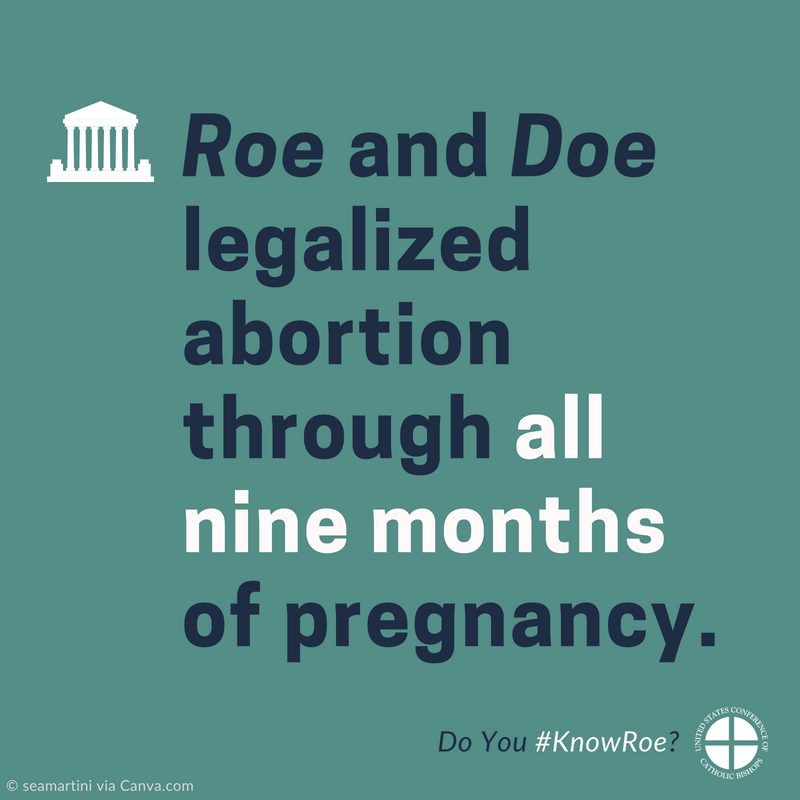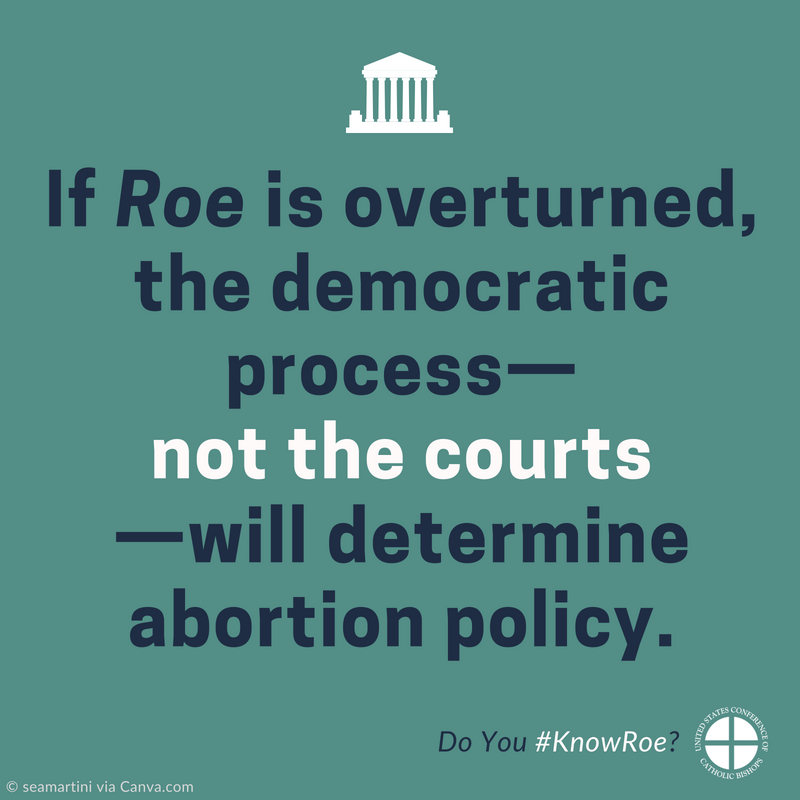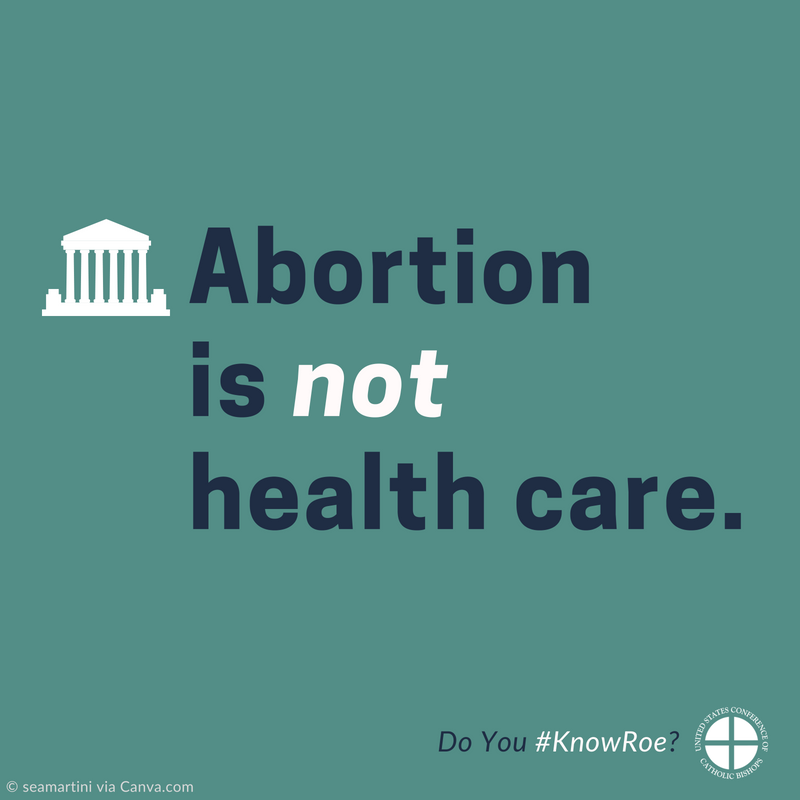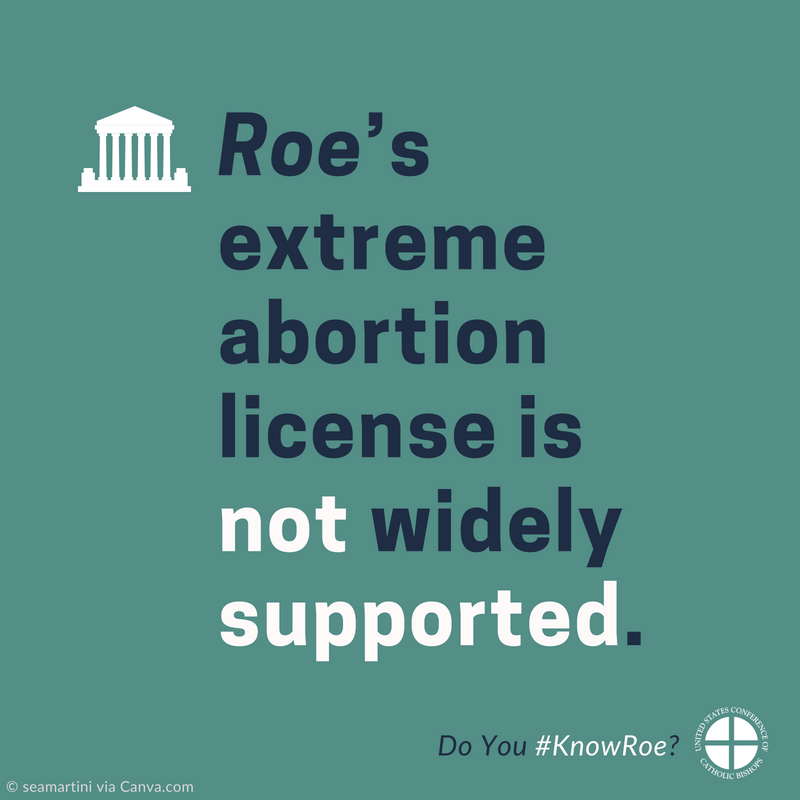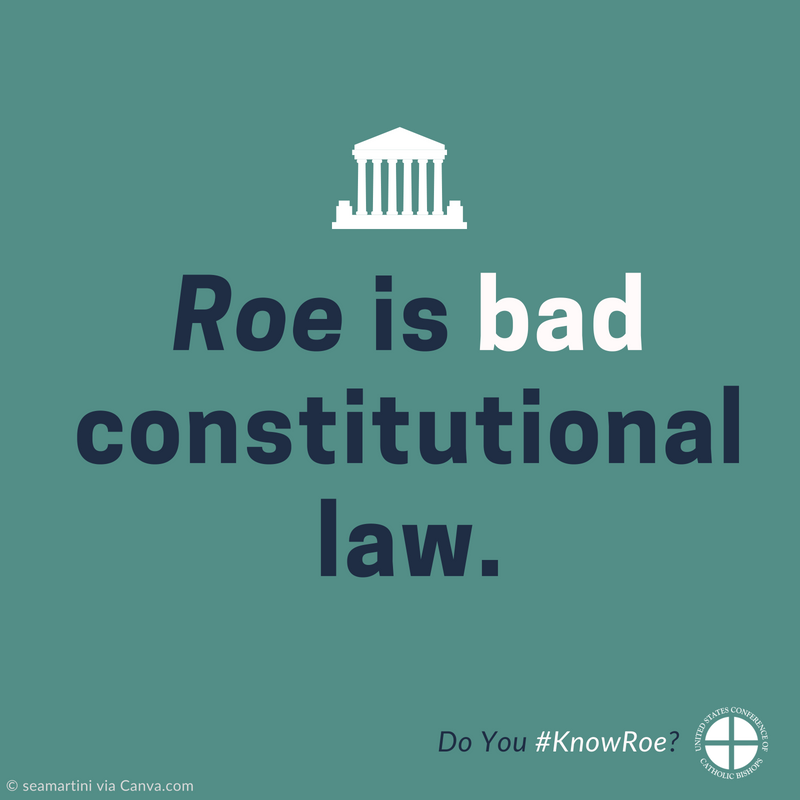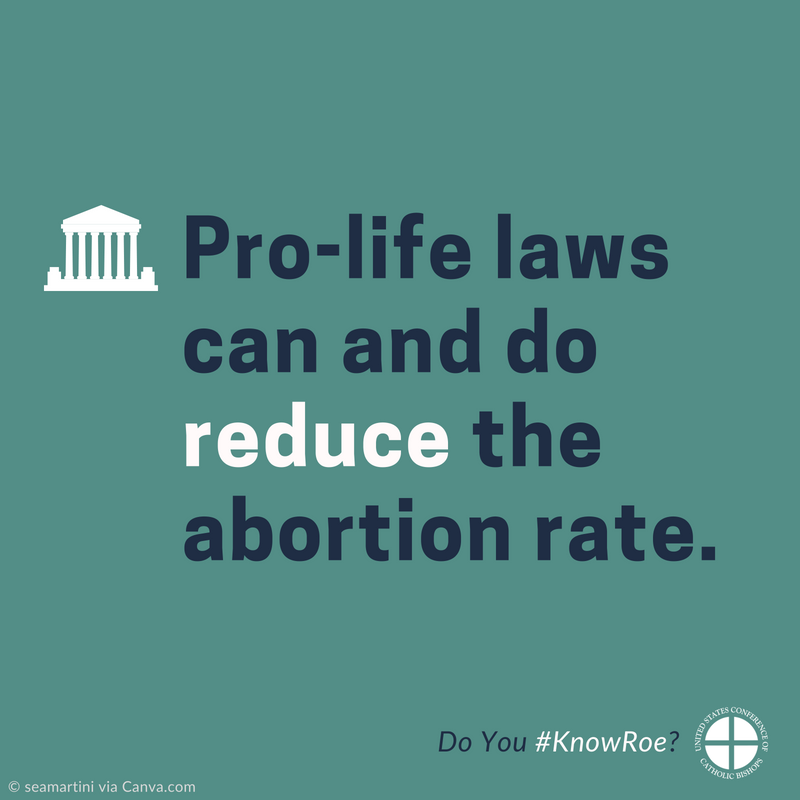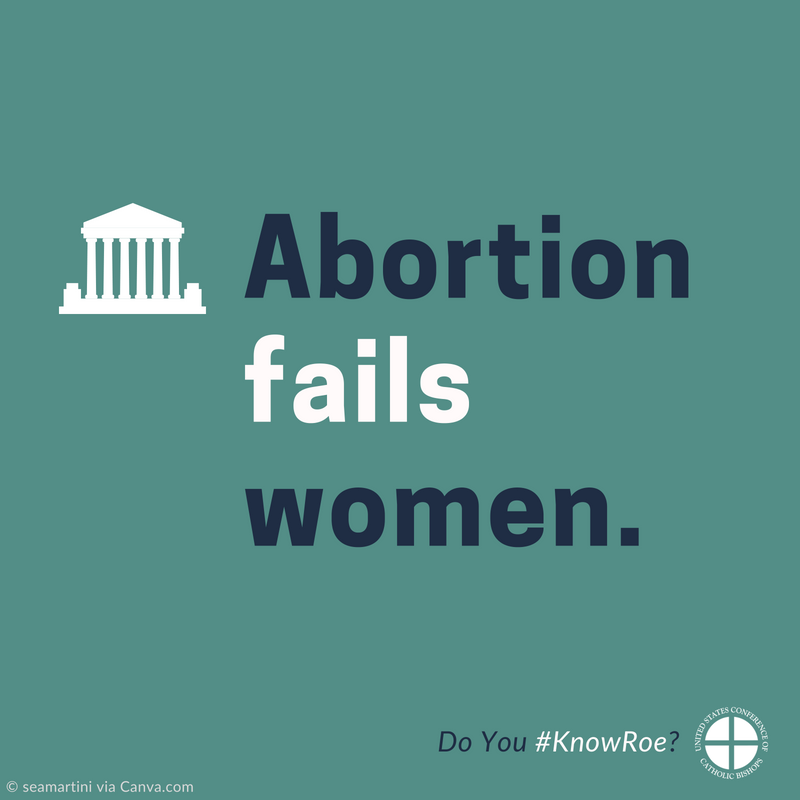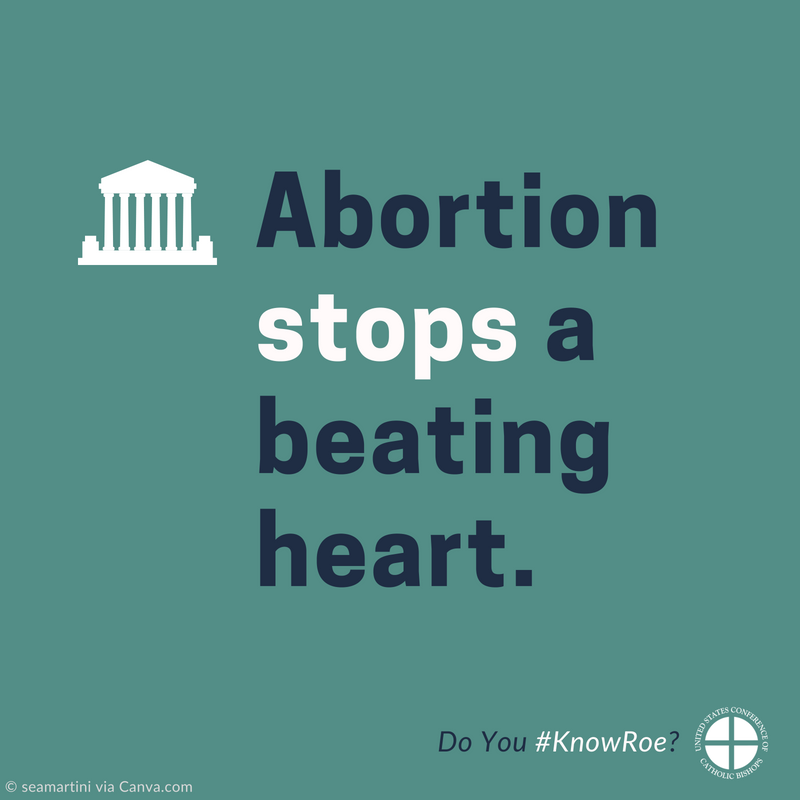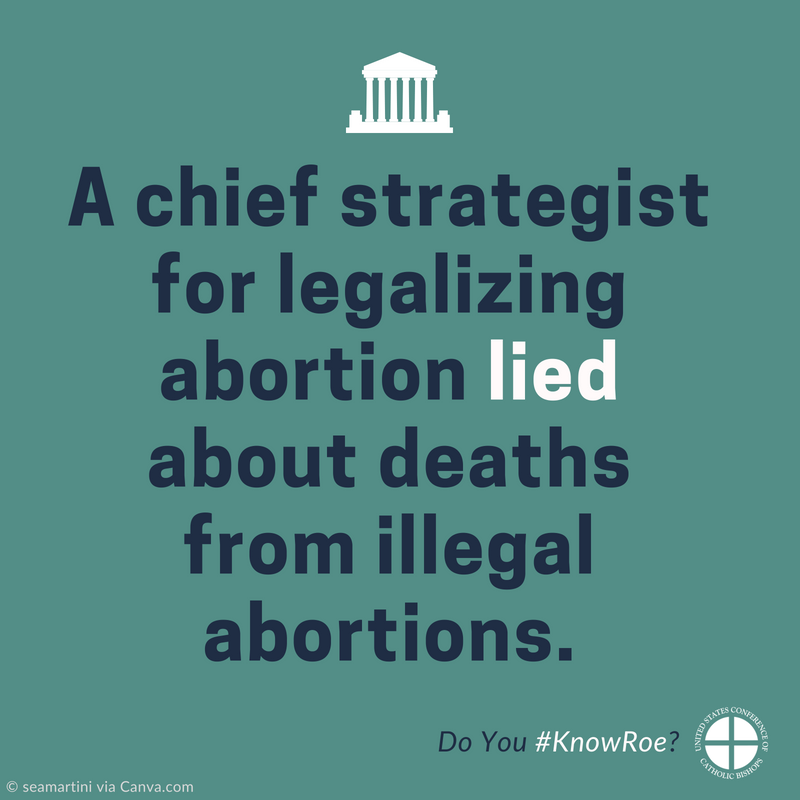¿Conoces a Roe?
Roe and Doe legalized abortion through all ninemonths of pregnancy
PDF | Word
Shareable Images
Many
people don't realize that Roe v. Wade
legalized abortion through all nine months of pregnancy. Roe says abortions may not be restricted at all during the first
three months and in the second three months may be regulated only for the
mother's health.1
After "viability"2
Roe allows abortion to be prohibited
but must make an exception for the woman's life or
health.3
But in Roe's companion case, Doe v. Bolton, the Court defined "health" to include "all
factors—physical, emotional, psychological, familial, and the woman's
age—relevant to the well-being" of the mother.4 In most
states, that is broad enough to permit virtually any abortion in the seventh, eighth,
or ninth months of pregnancy5 if any of these reasons is invoked.6
If Roe is overturned, the democratic process—not the courts—will determine abortion policy
Before Roe, all states permitted abortion if necessary to save the mother's life, and some permitted abortion in additional circumstances.7 But Roe deemed any prohibition on abortion as unconstitutional.
If Roe is overturned, policy decisions about abortion will be made by the citizens of each state through the democratic process, rather than by courts. Some states will place limits on abortion, in others there will likely be few limits.8
Not
until Roe v. Wade is reversed will
the people again be able to govern themselves on the important public policy
issue of abortion.
Abortion is not health care
Abortion
advocates speak as if abortion is health care, a procedure that is morally and
emotionally equivalent to surgically removing one's tonsils or appendix. It is
often conveyed as so morally neutral that only a few religious outliers find it
objectionable. Yet in reality, the vast majority, over 85%, of OB/GYNs, coming
from many faiths or no faith refuse to be associated with or perform an
abortion.9 In addition, according to
the pro-abortion Guttmacher Institute, 86% of hospitals were not involved in
abortion.10
Finally, even Roe acknowledges that
abortion is unlike other procedures performed by a health professional and that
unborn children deserve some protection.11 Abortion is not health
care and we do a disservice to women and health care providers to pretend it
is.
Roe's extreme abortion license is not widely supported
Abortion advocates claim that Roe enjoys broad public support and some recent polls seem to provide evidence for this claim. But most polls don't explain Roe's extreme abortion license and some misrepresent it. For example, a 2016 Pew Research Center poll claims 69% of Americans favor Roe v. Wade and 28% oppose it.12 But the poll wrongly describes Roe as establishing "a woman's constitutional right to an abortion, at least in the first three months of pregnancy." The fact is, Roe made abortion legal through all 9 months of pregnancy and for virtually any reason.13
The vast majority of Americans oppose the policy of nearly unlimited abortion dictated by Roe, and most believe abortion should not be legal for the reasons it is most often performed. A May 2018 Gallup poll shows that 65% of Americans said abortion should be illegal in the second trimester and 81% said abortion should be illegal in the last trimester.14 A 2018 Marist poll shows that 51% of women said abortion should never be permitted (9%) or permitted only in cases of rape, incest, and to save the woman's life (42%).15
So why do polls
show a majority of Americans favoring Roe
v. Wade? Because they don't really know what Roe did.
Roe is bad constitutional law
Even legal experts who support abortion believe Roe is not well-reasoned and is a case of extreme judicial overreach.
- The late Yale Law Professor John Hart Ely said, Roe v Wade is "a very bad decision . . . because it is not constitutional law and gives almost no sense of an obligation to try to be."16
- Attorney Edward Lazarus, former law clerk to Roe's author, Justice Blackmun, put it this way: "As a matter of constitutional interpretation and judicial method, Roe borders on the indefensible . . . [It is] one of the most intellectually suspect constitutional decisions of the modern era."17
- Harvard Law Professor Lawrence Tribe criticized Roe saying, "behind its own verbal smokescreen, the substantive judgment on which it rests is nowhere to be found."18
- Justice Sandra Day O'Connor said, "The Court's abortion decisions have already worked a major distortion in the Court's Constitutional jurisprudence . . . no legal rule or doctrine is safe from ad hoc nullification by this Court."19
- And then-Circuit Judge (now Justice) Ruth Bader Ginsburg said Roe "ventured too far in the change it ordered and presented an incomplete justification for its action."20
When experts on both sides of the abortion debate agree that Roe is bad law, reversing it makes good
legal sense and would return abortion policy back to the people to be decided
through the democratic process.
Pro-life laws can and do reduce the abortion rate
Most
people on both sides of the abortion debate agree that reducing the number of abortions
is a desirable outcome. While some argue that contraception is the key to
reducing the abortion rate, real-world evidence does not back that up. Instead,
research shows that even when women were provided with free "emergency
contraception" ahead of time, the pregnancy and abortion rate remained
statistically equivalent with those who were not provided with it.21 In fact, the
availability of contraception and abortion can increase the rate of unintended
pregnancies (as well as sexually transmitted infections) as studies show that
people engage in more frequent and riskier behavior if they believe their risk
has been lowered.22
On the other hand, evidence suggests that laws restricting the funding of
abortion (like the Hyde amendment preventing Medicaid funds from going to
abortion) or limiting its availability, involving parents, and providing women
with more information lower the rate of abortion.23 Unfortunately, Roe, its companion case Doe, and some subsequent rulings have been used to invalidate many laws
meant to lower the rate of abortion.
Abortion fails women
Abortion
is often portrayed as essential for women to achieve freedom and equality with
men, yet many report feeling some degree of pressure or aborting to please
someone else—often their partner.24 Further, after the
abortion, many women report feelings of depression, suicidal or self-harm
inclinations, sadness, shame, and regret.25 For example, Cynthia
Carney in an amicus brief submitted to the Supreme Court described the
aftermath of her abortion saying, "For 23 years, I went into crying spells,
depression, suicidal thoughts. Emotionally it devastated me." Camelia Murphy
explained, "I have suffered with low self-esteem, self-hatred, suicidal
impulses, constant anxiety (especially about sex and about making decisions)."
Donna Razin said that her abortion caused her "[d]eep regret—initially I was suicidal—as the years have progressed I have developed
a heightened level of bitterness and anger and self-hate."26 Women would be better
served if society tried to creatively answer the needs of single mothers,
mothers trying to get through school, mothers needing higher or more stable
finances, etc. rather than telling them that the death of their children is the
best answer. We can and should do better for all women.
Abortion stops a beating heart
Abortion advocates usually refer to the human being growing in her/his mother's womb in dehumanizing terms like "product of conception" and suggest that most abortions are done before fetal organs are functioning.
Actually,
the vast majority are done after the fetal heart has begun beating. A baby's heart
begins to beat at about 21 or 22 days after fertilization.27 That's at about 3
weeks of development. The vast majority of abortions in the United States are
done well after this point.28
Chief strategist for legalizing abortion lied about deaths from illegal abortions
Claims that thousands of women were dying from illegal abortions at the time of Roe were fabricated for political purposes. The late Dr. Bernard Nathanson, a chief strategist for legalizing abortion, said he and his associates invented the "nice, round shocking figure" of "5,000 to 10,000 deaths a year" from illegal abortions:
I confess that I knew the figures were totally false, and I suppose the others did too if they stopped to think of it. But in the "morality" of our revolution, it was a useful figure, widely accepted, so why go out of our way to correct it with honest statistics?29
Research confirms that the actual number of maternal deaths resulting from abortion in the 25 years prior to 1973 averaged 250 a year, with a high of 388 in 1948.30 In 1966, before the first state legalized abortion, 120 mothers died from abortion.31 While any death is a tragedy, by 1972, when abortion was still illegal in 80 percent of the country, the number dropped to 39 maternal deaths from abortion.32
Furthermore, a groundbreaking 2012 study of abortion in Chile published in a peer-reviewed scientific journal found that Chile's abortion prohibition in 1989 did not cause an increase in the maternal mortality rate (MMR). On the contrary, after abortion was prohibited, the MMR decreased by 69.2% in the following fourteen years.33
Shareable Images
1 In the first trimester, "[T]he abortion decision . . . must be left to the medical judgment of the pregnant woman's attending physician." In the second trimester, the State may "regulate the abortion procedure in ways that are reasonably related to maternal health." Roe v. Wade, 410 U.S. 113 (1973) at 164.
2 "[T]hat is, potentially able to live outside the mother's womb, albeit with artificial aid." Roe, at 160.
3 After viability, the State may "proscribe" abortion "except where it is necessary, in appropriate medical judgment, for the preservation of the life or health of the mother." Roe, at 164–65.
4 Doe v. Bolton, 410 U.S. 179 (1973) at 192. The "Doe v. Bolton ... opinion and this one, of course, are to be read together." Roe, at 165.
5 In Planned Parenthood v. Casey, the Court abandoned the trimester framework but reaffirmed the legality of abortion "subsequent to viability" for the "preservation of the . . . health of the mother." 505 U.S. 833 (1992) at 879.
6 The Supreme Court, however, has yet to be confronted with a challenge to a post-viability ban that will test Doe's breadth. Indeed, 20 states currently ban late-term abortions subject to a narrow exception for the mother's life or physical health (not for emotional, psychological, familial, or age-related reasons). Most of these laws have gone unchallenged, but they are hard to enforce even if they are constitutionally permissible.
7 Paul Benjamin Linton, "Planned Parenthood v. Casey: The Flight from Reason in the Supreme Court," Saint Louis University Public Law Review 13, no. 1 (1993): 24–26.
8 Benjamin Wittes, "Letting Go of Roe," The Atlantic Monthly, January/February 2005, 48.
9 Debra B. Stulberg, et al., "Abortion Provision Among Practicing Obstetrician-Gynecologists," Obstetrics and Gynecology, 118, no. 3 (September 2011): 609–614, https://journals.lww.com/greenjournal/Fulltext/2011/09000/Abortion_Provision_Among_Practicing.16.aspx.
10 Stanley K Henshaw, "Abortion Incidence and Services in the United States, 1995–1996," Perspectives on Sexual & Reproductive Health 30, no. 6 (November/December 1998): 263–70, https://www.guttmacher.org/journals/psrh/1998/11/abortion-incidence-and-services-united-states-1995-1996.
11 "[T]he right of privacy, however based, is broad enough to cover the abortion decision; that the right, nonetheless, is not absolute and is subject to some limitations; and that at some point the state interests as to protection of health, medical standards, and prenatal life, become dominant . . . . The pregnant woman cannot be isolated in her privacy. She carries an embryo and, later, a fetus . . . The situation therefore is inherently different from [other situations where the Court has recognized a constitutional right of privacy, such as] marital intimacy, or bedroom possession of obscene material, or marriage, or procreation, or education." (Emphasis added) Roe, at 155 and 159.
12 Pew Research Center, "Low Approval of Trump's Transition but Outlook for His Presidency Improves" (December 2016), Q.96F1, p 71, https://assets.pewresearch.org/wp-content/uploads/sites/5/2016/12/08135748/12-08-16-December-political-release.pdf.
13 See supra notes 1–5.
14 Gallup News Service, "Gallup Poll Social Series: Values and Beliefs" (May 1–10, 2018), Q.15, https://news.gallup.com/file/poll/235634/180613AbortionTrimesters.pdf.
15 Knights of Columbus/Marist Poll, "Abortion Limits Favored," (January 2018), https://www.kofc.org/un/en/resources/communications/kofc-marist-poll-national-nature-sample-tables2017.pdf.
16 John Hart Ely, "The Wages of Crying Wolf: A Comment on Roe v. Wade," Yale Law Journal 82, no. 5 (April 1973): 947, https://pdfs.semanticscholar.org/57de/57a09824f1bdca05e47c898a46e717618d23.pdf.
17 Edward Lazarus, "The Lingering Problems with Roe v. Wade, and Why the Recent Senate Hearings on Michael McConnell's Nomination Only Underlined Them," FindLaw, October 3, 2002, https://supreme.findlaw.com/legal-commentary/the-lingering-problems-with-roe-v-wade-and-why-the-recent-senate-hearings-on-michael-mcconnells-nomination-only-underlined-them.html.
18 Lawrence H. Tribe, "Foreword: Toward a Model of Roles in the Due Process of Life and Law," Harvard Law Review, 87, no. 1, (Nov. 1973): 7.
19 Thornburgh v. American College of Obstetricians and Gynecologists, 476 U.S. 747 (1986) (O'Connor dissenting), at 814.
20 Ruth Bader Ginsburg, "Some Thoughts on Autonomy and Equality in Relation to Roe v. Wade," 63 North Carolina Law Review 63, no. 2 (January 1985): 376, https://scholarship.law.unc.edu/cgi/viewcontent.cgi?article=2961&context=nclr.
21 United States Conference of Catholic Bishops, "Fact Sheet: Emergency Contraception Fails to Reduce Unintended Pregnancy and Abortion," June 5, 2014, (citing authority), https://www.usccb.org/issues-and-action/human-life-and-dignity/contraception/fact-sheets/emergency-contraception-fails-to-reduce-unintended-pregnancy-abortion.cfm.
22 For more information, see USCCB fact sheets: "Emergency Contraception Fails to Reduce Unintended Pregnancy and Abortion," and "Greater Access to Contraceptives Does Not Reduce Abortions," March 17, 2011, https://www.usccb.org/issues-and-action/human-life-and-dignity/contraception/fact-sheets/greater-access-to-contraception-does-not-reduce-abortions.cfm.
23 Michael J New, "Analyzing the Effect of Anti-Abortion US State Legislation in the Post-Casey Era," State Politics and Policy Quarterly 11, no. 1 (March 2011), 42, https://journals.sagepub.com/doi/abs/10.1177/1532440010387397.
24 Priscilla Coleman, et al., "Women Who Suffered Emotionally from Abortion: A Qualitative Synthesis of Their Experiences" Journal of American Physicians and Surgeons 22, no. 4 (Winter 2017), 115, https://www.jpands.org/vol22no4/coleman.pdf.
25 Brief of Sandra Cano, the former "Mary Doe" of Doe v. Bolton, and 180 women injured by abortion as Amici Curiae in support of Petitioner. Gonzales v. Carhart, 550 U.S. 124 (2007) (Nos. 05-380, 05-1382), https://thejusticefoundation.org/wp-content/uploads/2011/10/Gonzales-v.-Carhart-Amicus-Brief-Excerpts.pdf.
26 "Brief of Sandra Cano, the former 'Mary Doe' of Doe v. Bolton, and 180 women injured by abortion as Amici Curiae in support of Petitioner," Gonzales v. Carhart, 550 U.S. 124 (2007), 22–24, https://thejusticefoundation.org/wp-content/uploads/2011/10/Gonzales-v.-Carhart-Amicus-Brief-Excerpts.pdf.
27 Keith L. Moore and T.V.N. Persaud, The Developing Human: Clinically Oriented Embryology, 7th ed. (Philadelphia: W.B. Saunders Co., 2003), 330.
28 60% are done after the 6th week of "gestational age" counting from the last menstrual period, or the 4th week of development. Tara C. Jatlaoui, et al., "Abortion Surveillance—United States, 2014," Morbidity and Mortality Weekly Report, Surveillance Summaries 66, no. 24 (2017), 1–48.
29 Bernard Nathanson, Aborting America (New York: Doubleday, 1979), 193.
30 Ibid, 42.
31 From the U.S. Bureau of Vital Statistics Center for Disease Control, as cited in Dr. and Mrs. J. C. Wilke, Abortion: Questions and Answers, revised edition (Cincinnati: Hayes Publishing, 1990), 169.
32 Ibid.
33 Elard Koch, et al., "Women's Education Level, Maternal Health Facilities, Abortion Legislation and Maternal Deaths: A Natural Experiment in Chile from 1957 to 2007," PLoS ONE 7, no. 5 (May 2012), https://journals.plos.org/plosone/article?id=10.1371/journal.pone.0036613.
7/18/18

